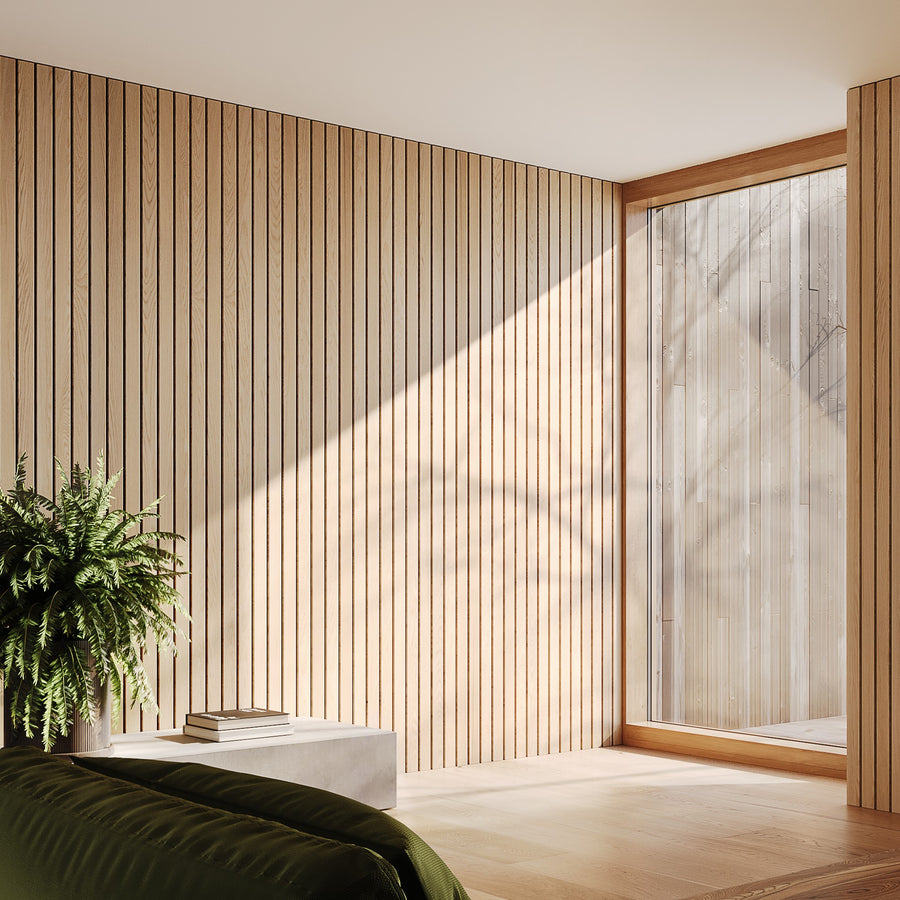The 5 Easiest Ways to Hide Cracks in Walls

Let’s face it, cracks in walls are a downright eyesore.
But they can be more than just an aesthetic problem! They can also be the sign of sudden temperature changes, the natural settling of a newly constructed building, or more serious structural issue..
Over time, homeowners and designers have found smart ways to cover wall imperfections without costly repairs.
From decorative Medieval tapestries to intricate Victorian-era wallpapers, covering wall imperfections has always been a concern.
With today’s technological advancements in materials and creative ideas on design trends, there are even more ways to solve this common problem in an effective and stylish way.
Before you start covering any cracks, it's essential to determine their seriousness. If the hairline cracks indicate structural damage, cosmetic fixes won’t be sufficient, and a professional should assess the issue.
Structural cracks might be due to foundational problems or severe wear, and overlooking them can lead to costly repairs or even safety hazards down the line.
Once the structural integrity is confirmed, and the cracks are deemed non-threatening, you can proceed with innovative ways to hide hairline cracks in wall and keep your home looking fresh and flawless.
Whether you’re dealing with minor cosmetic issues or more noticeable structural cracks, here are the five best and easiest ways on how to hide cracks in your wall.
Determining the Seriousness of the Crack
Before jumping into covering cracks, it's important to assess their seriousness. Not all wall cracks are created equal — some are harmless and purely cosmetic, while others could signal more serious underlying issues.
A good first step is to determine whether the cracks are hairline or more substantial. Hairline cracks, often caused by temperature changes or the settling of a home, are usually harmless and can be filled in with basic drywall filler.
However, larger cracks, particularly those wider than 1/8 inch or showing signs of movement, could be a sign of structural damage, and it's best to consult a professional before proceeding.
Solutions Based on the Problem's Severity
Once you've determined the severity, the type of solution you use will depend on how serious the crack is and what your end goal is. For minor, hairline cracks, drywall patching is an effective option.

Drywall filler can smooth out the surface, and this solution works well for cracks that won't require a more durable fix.
If you're planning to wallpaper over the area, smoothing out the cracks first ensures a seamless application and better results.
If you're going to be installing decorative wall paneling overtop of the cracks, you won't need to patch the cracks as the panels will cover any cosmetic issues.
Keep reading for some of the best options for hiding cracks in walls, with helpful info on installation and choosing the right one for your space.
1. Wallpaper
Wallpaper has been a go-to solution to cover wall imperfections for hundreds of years, dating back to the Medieval period when it was considered a luxury art piece hand-painted on rice paper.
Today, wallpapers are an affordable choice for hiding wall cracks, available in various textures, patterns, and materials like fabric and vinyl, allowing for customization based on your room’s theme.
Thicker wallpapers are especially effective at hiding cracks because they can better mask imperfections. In contrast, thinner or glossy wallpapers might reveal these flaws instead of concealing them.
For a stylish and functional option, consider faux concrete wallpaper, which provides a textured look that effectively camouflages any cracks or uneven surfaces.
How to Apply
Properly prep the wall by cleaning the surface and removing any debris or dust. Then apply a primer so that the wallpaper will stick better.
Wallpapers with busy patterns or heavy textures are recommended if you want to hide cracks as they conceal the visible imperfections. Start sticking the wallpaper from the top and work your way down.
Smooth out air bubbles that might appear along the way using a smoothing tool or wallpaper brush. We recommend you use a wallpaper with strong adhesive backing. You can also use a wallpaper liner if the wall cracks are deep.
2. Vertical Wide Wood Slat Paneling
Vertical wood slat panels are one of the most popular design features today. Not only are they aesthetic, but they also serve functional purposes — one of which is concealing wall cracks.
Their roots can be traced to mid-century interiors, which emphasize natural materials and clean lines. The panels pictured above are extra Wide Wood Slat Wall Panels, which have wider slats to create a more timeless and grounded look.
Today, they are popular in residential and commercial spaces due to their versatility and simplicity. These panels are available with an acoustic felt backing and real wood veneer, typically from walnut, oak, or ash wood, adding depth and texture while effectively covering cracks.
How to Apply
The nice thing about vertical wood slat paneling is that they are easy to install. Start by measuring the wall height and cutting each slat to the specific size, before using screws or adhesive to fix them to your wall. You can read our guide on How to Install Wood Slat Wall Panels for a more detailed look.
3. Textured Paint
Textured paint is a popular option for covering wall imperfections like cracks and holes in homes and commercial spaces. Recently, it has gained popularity due to its limewash effect, which emulates the look of classical European homes.
Textured paint is one of the best ways on how to hide cracks in wall because it is thicker than regular paint and contains particles like sand that create a textured finish.
This added thickness and texture make it more effective at covering cracks, adding durability, and making it ideal for high-traffic areas.
How to Apply
The first step to hide cracks in wall using textured paint is to prepare the wall by removing dust, dirt, and any loose paint.
For larger cracks, first use a drywall patch kit or spackling to fill the gaps, then sand the area smooth once it’s dry.
After preparing the larger cracks, apply the textured paint in multiple layers, allowing each layer to dry thoroughly before applying the next. You can also customize textured paint with different pigments or techniques like stippling or dragging to create unique patterns that further hide cracks.
4. Paintable Wall Panels
Paintable wall panels, like the fluted wall panels pictured above, are a versatile solution for hiding cracks, dents, and other imperfections. MDF panels are particularly popular because they offer a stylish, durable, and functional option that are still lightweight, easy to cut, and relatively affordable.
These panels are smooth, easy to paint, and come pre-primed, so there's no need for additional priming before painting. This makes them perfect for creating a seamless finish.
MDF panels can create accent walls while concealing cracks, offering a dual-purpose solution that is both aesthetically pleasing and durable.
They are available in various styles, such as beadboard, shiplap, wainscoting, and fluted wall paneling, allowing homeowners to choose a design that complements their decor.
How to Apply Fluted Wall Panelling
To install MDF paintable wall panels, start by measuring the wall and cleaning it to remove dust and debris. Cut the panels to the required size, ensuring they fit snugly around any obstacles like outlets or windows.

Apply adhesive to the back of each panel and press firmly against the wall, using a level to keep them straight. Secure with nails or screws for stability. Since these panels come pre-primed, you can proceed directly to painting with your chosen color using a brush for edges and a roller for flat areas. Reinstall trim for a polished, finished look for your paintable wall panel finish.
5. Hanging Art or Mirrors to Create a Gallery Wall

Hanging artwork or mirrors is another innovative way to conceal wall damage, serving both functional and aesthetic purposes. It’s a simple solution for covering cracks, stains, or other imperfections.
However, this tactic to cover wall imperfections may be tricky for cracks that extend from the top of the wall to the ceiling. In such cases, it’s best to combine this method with using a drywall repair kit to patch the cracks, sanding the repairs down, and then adding multiple pieces of art to the wall to hide any imperfections that are still visible after patching.
Creating a gallery wall can also be a great strategy to divert attention from any lingering imperfections, as the varied arrangement of artwork draws the eye and enhances the room’s visual appeal.
Mirrors can make spaces appear larger and brighter, while artwork draws attention away from damage. This method is ideal for renters or homeowners seeking a quick fix without committing to permanent repairs, offering flexibility in decorating and maintaining appearances.
How to Apply
Select artwork or mirrors that not only complement your room’s style but are also large enough to cover the crack completely. When choosing a mirror, consider a beveled edge or an ornate frame to draw attention away from the wall behind it.
Use appropriate hardware for the weight to ensure secure hanging. This method works best for cracks in less-trafficked areas and is a quick fix for events or guests.
Moving Forward
Cracks in walls don’t have to be a permanent blemish in your living space. By following the five methods on how to hide cracks in walls, you can easily conceal any imperfections and add personality to your home.
Each method is an effective way to cover wall imperfections, depending on the location and severity of the damage. Whether you are looking for a temporary fix or long-term solution, these strategies give flexibility and allow you to maintain both the aesthetics and structural integrity of your home.
With a little more effort and a touch of creativity, you can bid farewell to unsightly cracks as you welcome your new beautiful wall.








































Great tips! Hiding wall cracks can be simple with methods like spackling, painting tricks, textured finishes, decorative molding, or wall art to keep your walls looking smooth and fresh.
ChatGPT said:
Practical and creative ways to conceal wall cracks! Easy and effective solutions.
Leave a comment